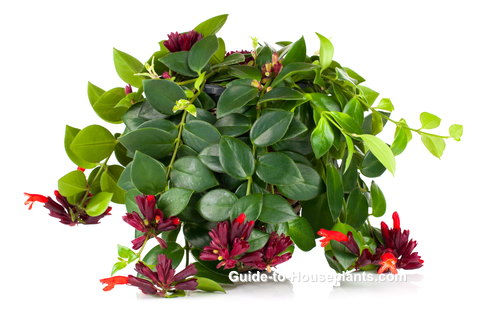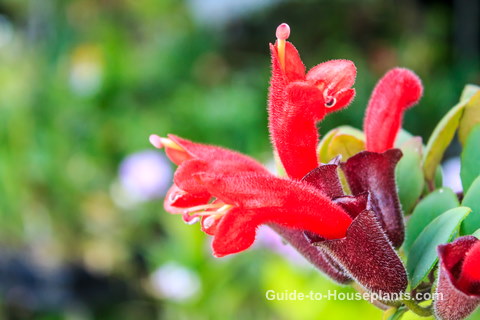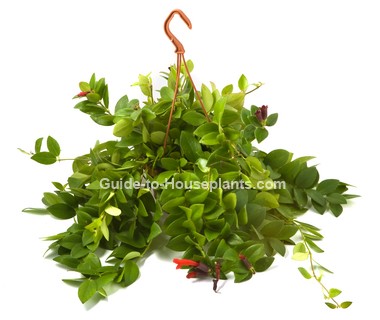How to Grow Aeschynanthus lobbianus Indoors
Botanical Name: Aeschynanthus radicans
Easy-care Lipstick Plant is ideal for a hanging basket. Putting it at eye-level will show off its thickly leaved trailing vines with spectacular flowers.

In their native rain forest habitat, these evergreen plants grow as epiphytes, perched on trees, where their long vines sprawl along moss-covered branches. Give these tropical flowering house plants the same dappled sunlight and humidity and they’re extremely easy to grow.
The thick, glossy leaves are 2-4 in (5-10 cm) long and cover the trailing stems, making this vine a lush, tropical accent for your home.
The real attraction, though, is its tubular flowers that emerge from a calyx in bright colors that look like lipstick in a tube. Most often, you’ll find them in red, but some rarer varieties have dark red, orange, yellow or coral blooms.

Aeschynanthus Varieties
You’ll find several species of Aeschynanthus labeled Lipstick Plant or Lipstick Vine. ‘Variegated’ has a creamy white leaf variegation and bright red blooms. ‘Fireworks’, ‘Frostfire’ and ‘Flash’ are all showy hybrids with fiery red flowers. ‘Mona Lisa’ is a prolific bloomer with clusters of red flowers.
Caring for Lipstick Plant Year-Round
To repot…or not. Lipstick plants don’t mind being repotted. Repot in spring or summer when the roots fill the pot, moving it up to a pot only 1 to 2 inches larger. Keeping the plant slightly pot-bound will help it to bloom.
Prune it back. Prune back stems after flowering as needed. You can cut up to 1/3 of the plant to prevent it from getting leggy and to encourage branching. Flowers grow near the tips of new stems, so you’ll get more blooms this way.
Pruning Tip
Always prune after a leaf node (the place where a leaf is attached to the stem). Use sharp, clean pruning shears to avoid jagged tears and disease.
Raise the humidity. If the relative humidity drops below 50%, use a pebble tray or cool-mist room humidifier to increase the moisture in the air. Regular misting helps, too. Remember that hanging plants are exposed to warmer air near the ceiling that can dry them out faster.
Give it a winter rest. Giving this plant a slightly cooler, drier rest in winter will promote more blooms in spring and summer. Stop fertilizing during this time and keep the plant in bright light. Keep it away from heat vents and cold blasts from doors and windows.
Lipstick Plant Care Tips

Origin: Southeast Asia
Height: Trailing stems up to 2 ft (60 cm) long.
Light: Bright light with some direct sun in winter. Plants that don’t bloom aren’t getting enough light. Place your plant in a bright location and you can expect flowers all spring and summer.
Water: Water thoroughly spring through fall, allowing the soil to dry out slightly between waterings. Keep the soil slightly drier in winter when growth is slower. Wrinkled leaves are a sign of dry soil. Yellow leaves usually indicate too much water.
Humidity: Try to keep relative humidity around 50% or higher. Indoor air can become extremely dry during the winter months without our noticing it. It’s a good idea to use a humidity monitor near the plant, rather than guess. Discover easy ways to increase humidity for your tropical houseplants.
Temperature: Average room temperatures 65-75°F/18-24°C. This tropical native doesn’t like temperature swings — keep it away from heat/AC vents and cold drafts from doors and windows.
Soil: Peat moss based potting mix. Added perlite will help to aerate the roots and speed up drainage, preventing waterlogged soil. African violet potting mix is ideal for Lipstick Plant.
Fertilizer: Feed every 2 weeks spring through fall with a water-soluble fertilizer, diluted by half. Use a fertilizer that is high-phosphorus to help it bloom (such as N-P-K 15-30-15). Do not feed in winter.
Propagation: Take 4-6 in (10-15 cm) stem tip cuttings in spring or summer.




